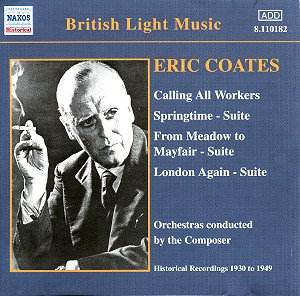An exact contemporary of Albert Sammons – they even
died in the same year, four months apart – Eric Coates began his professional
life, as had that illustrious violinist, as a chamber and orchestral
player of repute. He was a student of Lionel Tertis at the Royal Academy
of Music and a second study composition pupil of Frederick Corder before
joining the Hambourg String Quartet for a South African tour. He had
the good fortune to be taken on the infamous Beecham Symphony Orchestra
British tour in 1910 – Sammons was the leader, orchestra members regularly
uncoupled railway carriages and threw chandelier lights from great heights
in expensive hotels and Beecham progressively cut Elgar’s First Symphony
until it resembled more an amputation than a composition. Coates remembered
the time as one of the most scintillating experiences of his life. His
later service in Wood’s Queen’s Hall Orchestra was a little more staid.
He began composing early and the recordings documented
on this disc, if neither as well known or accomplished as his more famous
works, are nevertheless brimful with verve, imagination and directness.
The 1940 Calling All Workers is the most well established piece,
superbly recorded and conducted – it’s an 'object listen' to hear Coates’
use of the bass line here. As with most composer-conductors he is straight-forward,
fleet, unsentimental and supremely accomplished in his own music – and
this is repertory that has seen more than its share of magnificent performers;
Charles Groves, Stanford Robinson, Reginald Kilbey and Adrian Boult
amongst many. Springtime was recorded in 1937 hot off the press.
Completed that year, first performed by the BBC – staunch advocates
of Coates’ music – he doesn’t refer to it in his autobiography, a striking
omission, though the reason may be to do with its backward looking vein
of turn of the century nostalgia; it certainly seems unusually retrogressive
stylistically for 1937 and quite probably it was a bottom drawer triptych
revival – the second movement Romance especially so. From
Meadow to Mayfair represents a little watershed in Coates’ compositional
career. Composed between 1930-31 it includes the little rusticisms that
were soon to be subsumed into his more cosmopolitan style; if there
was ever a crux in the town and country elements in his imaginative
writing this was the moment – the pastoral giving way to the march.
In his memoirs Coates called the work a kind of farewell to his native
Nottinghamshire and it was a kind of envoi in his music. Although he
admired Gershwin he admired Richard Rogers more. The Symphonic Rhapsody
- With a Song in my Heart is most unusual inasmuch as it’s the only
arrangement by Coates of another composer’s work – a big, rich, burgeoning
tribute. London Suite - Again reminds us of the remarkable success
of the earlier suite – once more the BBC took a first performance without
a prior public outing. It’s undoubtedly inferior to the London Suite
which it has never matched in popularity but it does bustle along
in fine fashion, exploiting deft orchestration to picture-paint Oxford
Street, Langham Place and Mayfair. By the Tamarisk – the kind
of title British composers gave to their quartet movements – is affecting
and The Three Bears receives a pin-point performance, witty and
effortlessly inflected, and well captured by the Decca recording team
of 1933.
Post-War, Coates continued to make recordings not least
with the so-called Philharmonic Promenade Orchestra for EMI and with
the New Symphony for Decca. He was a bracing and imaginative conductor
whose works were written from the inside with a performer’s understanding.
Don’t be confused by the front of the booklet – these recordings date
from 1930-40 and not 1949. They are also delightfully evocative and
well worth your money.
Jonathan Woolf
See also MusicWeb
Eric Coates pages


